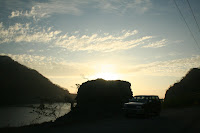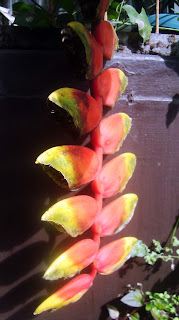Old Bridge across Banaoang Pass
"You are a peacemaker and guardian, oh, bridge,
rather than a bridge of sigh;
You tame the wind, the river, and the mountains,
and countless passersby." avr
Dr Abe V Rotor
Living with Nature School on Blog
Old Bridge across Banaoang Pass in acrylic (60" x 41") by the author.
Painted for Dr Laurence (Rencie) Padernal), April 29. 2012
Past your golden age, three generations have passed,
Once in your prime, and also was mine;
The world over the horizon across your span, I sought
For dreams the sweet goal of time.
While across your other end leads to home, sweet home,
For loyal sons and daughters in homage,
Returning to childhood memories, to peaceful repose,
Gateway indeed you are to every age.
And in between, fleeting were the years, but never
Lost - dream fulfilled, or never was -
Matters but little in your own world, bright and windy,
As the sun rises through the Pass.
And if a lonely soul comes to your world, gazes around
And high, the strength of the towering
Rocks, the sharp, gentle slopes of green and golden
In their pristine - they're Nature blessing.
From the cliff down the ravine, the great divide
Of the rugged Cordillera, surrenders
To a mighty river born in a fertile valley, gathers
Strength as it flows and meanders.
You are their peacemaker and guardian, oh, bridge -
And rather than a bridge of sigh,
You tame the wind; you tame the river, the mountains,
And every day countless passersby.
Bearing their weight and their load uncomplaining,
Their pain and joy of going and returning;
And seeing yonder farmers and fishers in their work -
All’s well ‘til the sky sent the river roaring.
Now it is your time to rest, the wind, river, and mountains
And I, to bid you goodbye in the setting sun;
But your ruins rise a monument seen by all and from Above,
Where once a boy with dreams crossed your span.
Presentation and unveiling of the painting to the birthday celebrant
Quirino Bridge is named after President Elpidio Quirino, a great Ilocano leader. It spans across the mighty Abra River passing through Banaoang Pass, and joining the towns of Santa and Bantay both in Ilocos Sur province. The bridge survived a recent strong typhoon but was soon retired and replaced by a new bridge. Its beauty however, cannot be equaled.
Twilight view to the East, source of the mighty Abra River
Sunset view to the West where the river empties to the South China Sea
Cirrus clouds over the Cordillera Range; promontory partly blocking the bridge's view to the West.
Placid river in summer, fisherman on raft steers for home before dark.
Exuberance of youth meets sunset on the edge of Banaoang Pass, as the Cordillera turns to amber and the Abra River to emerald. ~








2.jpg)



























